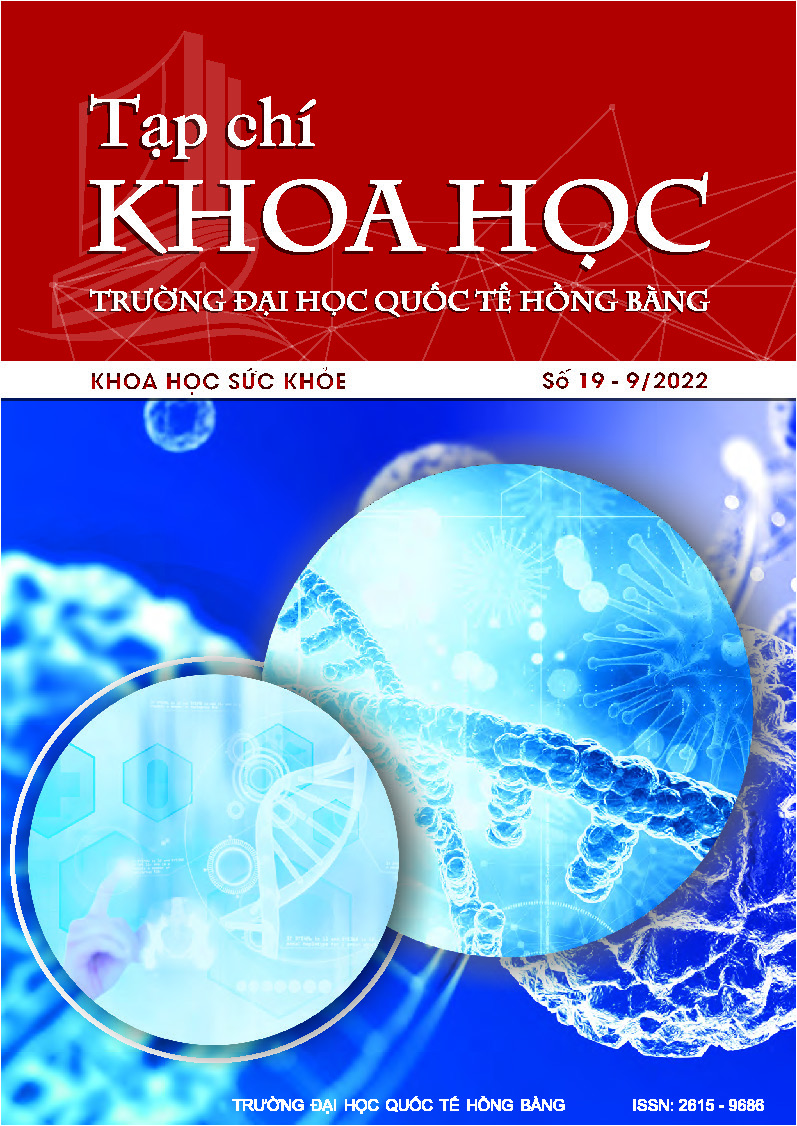Ứng dụng hỗ trợ vi sóng trong chiết xuất polyphenol từ lá chè Việt Nam (Camellia sinensis (L.))
Các tác giả
Từ khóa:
chiết xuất hỗ trợ vi sóng, lá chè, polyphenolTóm tắt
Trong bài nghiên cứu này, polyphenol được chiết xuất từ lá chè xanh Camellia sinensis (L.) bằng phương pháp tiền xử lý có hỗ trợ vi sóng sau đó thực hiện ngâm chiết trong dung môi được lựa chọn. Các yếu tố ảnh hưởng được khảo sát bao gồm độ phân cực của dung môi, công suất, thời gian vi sóng và tỷ lệ rắn:lỏng. Điều kiện thích hợp của quá trình chiết xuất có hỗ trợ vi sóng trước khi ngâm chiết bằng dung môi ethanol được xác định như sau: dung môi chiết trong vi sóng là nước, công suất vi sóng mức trung bình, thời gian 10 phút, tỷ lệ rắn:lỏng là 1:100. Kết quả thu được cao chiết có hàm lượng polyphenol tổng số là 38.93 mg GAE/g chất khô.
Abstract
This study represented the effect of microwave-assisted extraction methodology on the extract polyphenols from Green tea Camellia sinensis (L.) leaves. Four independent variables including the effect of solvent, microwave power, extraction time, and material-to-solvent ratio were investigated. The ideal extraction conditions are determined as follows: the microwave pretreatment was obtained with water concentration in medium power, an extraction time of 10 minutes, and the material-to-solvent ratio of 1:100 before being extracted by ethanol. Under these conditions, the total polyphenols amounted to 38.93 mg GAE/g dry weight.
Tài liệu tham khảo
[1] Đ. T. Lợi, ''Những cây thuốc và vị thuốc Việt Nam, lần 15''. Hà Nội: Nxb Hồng Đức, 2015.
[2] Bộ Nông nghiệp và Phát triển nông thôn, “PSAV,” Hà Nội, 18/12/2020. [Trực tuyến]. Địa chỉ: http://psav-mard.org.vn/hoi-thao-tong-ket-nganh-che-viet-nam-2020“5-nam-chuong-trinh-doi-tac-cong-tu-phat-trien-nganh-che-ben-vung-dinh-huong-giai-doan-2021-2025.html. [Truy cập: 25 06 2021].
[3] N. Miyoshi, M. Pervin, T. Suzuki, K. Unno, M. Isemura and Y. Nakamura, "Green tea catechins for well-being and therapy: prospects and opportunities," Botanics: Targets and Therapy, Vol. 5, pp. 85-96, 2015. DOI: 10.2147/BTAT.S91784.
[4] W. C. Tung, B. Rizzo, Y. Dabbagh,…, O. Dangles, K. Weikel and J. Vinson, “Polyphenols bind to low density lipoprotein at biologically relevant concentrations that are protective for heart disease,” Archives of Biochemistry and Biophysics, Vol. 694, 2020. DOI: 10.1016/j.abb.2020.108589.
[5] C. Fu, T. Wang, Y. Wang, X. Chen,…, F. Ma, M. Zhong and K. Bi, “Metabonomics study of the protective effects of green tea polyphenols on aging rats induced by d-galactose,” Journal of Pharmaceutical and Biomedical Analysis, Vol. 55, No. 5, pp. 1067-1074, 2011. DOI: 10.1016/j.jpba.2011.03.011.
[6] G. Ma and Y. Chen, “Polyphenol supplementation benefits human health via gut microbiota: A systematic review via meta-analysis,” Journal of Functional Foods, Vol. 66, 2020. DOI: 10.1016/j.jff.2020.103829.
[7] S. Deo, A. Janghel, P. Raut,…, A. Alexander, T. Giri and M. Sharrma, “Emerging microwave assisted extraction (MAE) techniques as an innovative green technologies for the effective extraction of the active phytopharma-ceuticals.,” Research Journal of Pharmacy and Technology, Vol. 8, No. 8, pp. 655- 666, 2015. DOI: 10.5958/0974-360X.2015.00104.3
[8] Z. E. Huma, V. Jayasena, S. Abbas, M. Imran and M. K. Khan , “Process optimization of polyphenol extraction from carob (Ceratonia siliqua) kibbles using microwave-assisted technique,” Food Processing and Preservation, Vol. 42, No. 2, 2017. DOI: 10.1111/jfpp.13450.
[9] R. G. Mahardika and O. Roanisca, “Microwave-Assisted Extraction of Polyphenol Content from Leaves of Tristaniopsis merguensis Griff,” Asean journal of chemical engineering, Vol. 19, No. 2, pp. 110-119, 2019.
[10] K. Kaderides, L. Papaoikonomou, M. Serafim and Athanasia M. Goula, “Microwave-assisted extraction of phenolics from pomegranate peels: Optimization, kinetics, and comparison with ultrasounds extraction,” Chemical Engineering and Processing - Process Intensification, Vol. 137, pp. 1-11, 2019.
[11] N. V. Tặng, T. T. M. Hạnh, P. C. An, P. T. B. Trâm, H. Q. Trung và T. T. Giang, “Ảnh hưởng của dung môi và phương pháp trích ly đến khả năng chiết tách các hợp chất Phenolics, Saponins và Alkaloid từ vỏ quả cacao (Theobroma cacao L.),” Tạp chí Khoa học Trường Đại học Cần Thơ, Tập 56, Số 4B, tr. 71-78, 2020. DOI: 10.22144/ctu.jvn.2020.084.
[12] J. Chen , W. P. D. W. Thilakarathna , T. Astatkie and H. P. V. Rupasinghe, “Optimization of Catechin and Proanthocyanidin Recovery from Grape Seeds Using Microwave-Assisted Extraction,” Biomolecules, Vol. 10, No. 2, 2020. DOI: 10.3390/biom10020243.
[13] M. Garcia-Vaquero, V. Ummat, B. Tiwwari and G. Rajauria, “Exploring Ultrasound, Microwave and Ultrasound-Microwave Assisted Extraction technologies to increase the extraction of bioactive compounds and antioxidants from Brown Macroalgae,” Marine Drugs, Vol. 18, No. 3, 2020. DOI: 10.3390/md18030172.
[14] TCVN 9745-1:2013, Chè - Xác định các chất đặc trưng của chè xanh và chè đen - Part 1: Hàm lượng polyphenol tổng số trong chè phương pháp đo màu dùng thuốc thử Follin-Ciocalteu.
[15] T. C. Sơn, ''Thẩm định phương pháp trong phân tích hoá học và vi sinh vật''. Hà Nội: Nxb Khoa học và Kỹ thuật, 2010.
[16] TCVN 9741:2013, Chè - Hòa tan dạng rắn. Xác định độ ẩm (hao hụt khối lượng ở 103o C).
[17] N. V. Thuỷ, N. N. Quý, P. V. Thịnh và H. L. Tý, “Ảnh hưởng của các điều kiện chiết tách đến hàm lượng polyphenol và flavonoid tổng của lá cây Mãng cầu xiêm (Annona muricata Linn.),” Tạp chí Khoa học & Công nghệ, Số 9, tr. 52-56, 2020.
[18] I. M. Savic and I. M. Savic Gajic, “Optimization of ultrasound-assisted extraction of polyphenols from wheatgrass (Triticum aestivum L.),” Journal of food science and technology, Vol. 57, No. 8, pp. 2809-2818, 2020. DOI: 10.1007/s13197-020-04312-w
[19] G. T. Khoa, B. Q. Thuật và N. X. Mạnh, “Bước đầu nghiên cứu ảnh hưởng của một số yếu tố công nghệ đến hiệu suất trích ly polyphenol từ lá chè Camellia sinensis (L) O. Kuntze”, Tạp chí Khoa học Nông nghiệp Việt Nam, Tập 15, Số 2, tr. 205-213, 2017.
[20] C. Yen, X. Quingzhong, L. Jing, Z. Changsheng, X. Fumin and Z. Yuzhong, “Decomposition of Five Phenolic Compounds in High Temperature Water”, J. Braz. Chem. Soc, Vol. 25, No. 11, pp. 2012-2017, 2014. DOI: 10.5935/0103-5053.20140201
[21] V. Anabella, R. Erison, B. Maria, D. Jonathan and R. E. Jhenea, “Production of green nano zero-valent iron (G-nZVI) particles using polyphenol extracts of Tawa-tawa (Euphorbia hirta linn) leaves and green tea (Camelia sinensis) leaves”, MATEC Web of Conferences, Vol. 268, 2019. DOI: 10.1051/matecconf/201926805005
[22] P. T. P. Thảo, T. T. T. Hằng, G. T. Khoa, H. Đ. Hòa và V. H. Sơn, “Ảnh hưởng của giống và vùng địa lý đến chất lượng hạt chè và dầu hạt chè Camllia sinensis O. Kuntze ở Việt Nam”, Tạp chí Khoa học và Công nghệ Việt Nam, Tập 62, Số 5, tr. 32-37, 2019.
[23] D. Evitasari and E. Susanti, “Total Polyphenol Content in Green Tea (Camellia sinensis) from Maceration with Comparison of Ethanol - Water Solvent”, PHARMADEMICA: Jurnal Kefarmasian dan Gizi, Vol. 1, No. 1, pp. 16-23, 2020.
Tải xuống
Tải xuống: 565







